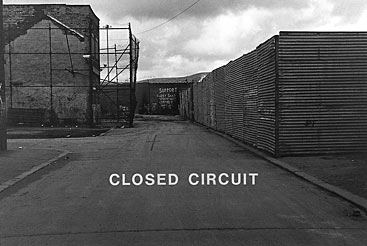
Born in 1959 in Derry (IE)
Lives and works in Derry (IE)

1989
Black and white photograph, gelatin-silver print
127 x 188 cm
Year of Purchase: 1990
‘Violence gathers power in the void of the screen, through the hole it opens up in the mental world.’1
Willy Doherty constructs emblematic images linked to the political events of terrorism in Northern Ireland, which have been going on since the 1970s. In the midst of this everyday and familiar presence of armed struggle, of the insidious loss of a territorial reality, and underlying insecurity, his work seeks out abandoned places, trace-places expressing a loss of identity, and an absence of the other. So as observers and partners of a political and social situation bogged down in a post-colonial struggle, his photographs, videos and their exhibition conditions are so many non-places, statements of an incapacity to see and express, which refuse all documentary location via a return to the abstract and referential world of the art scene.
The artist’s landscapes, portraits and roamings do not cling to anything specific. Closed Circuit shows a blocked road, an impasse which is not an impasse, relocated, generic, without any particular emotion, denouncing, echo-like, the everyday violence of an anonymous and identity-free urban fracture. The distancing processes used by Doherty, duality, play of similarity, image-text comparison, all destroy while mimicking the techniques of reporting and the cliches of social realism which the media manipulate to blur and reject any visible inclusion of terrorism in the public place. Within an ongoing duality between objectivity and subjectivity, and between content and style, the subject and the object respond to one another within the aesthetic evidence of images kept at a distance by the laconic prophecy of words. Similarly, the impression of an unstable boundary between victim and executioner becomes erased in the stable depth of landscapes disturbed by the immediate effect of a communication without any recipient.
Doherty’s politically committed art, on view as much in the street in the form of posters as in display areas devoted to art, lends visibility to a public place which is intolerant, fragmented and empty, etched in the configuration of the landscape, the nation, and the home.
Maïté Vissault
1 Jean Baudrillard, La transparence du mal, Paris, Galilée, 1990, p.82.